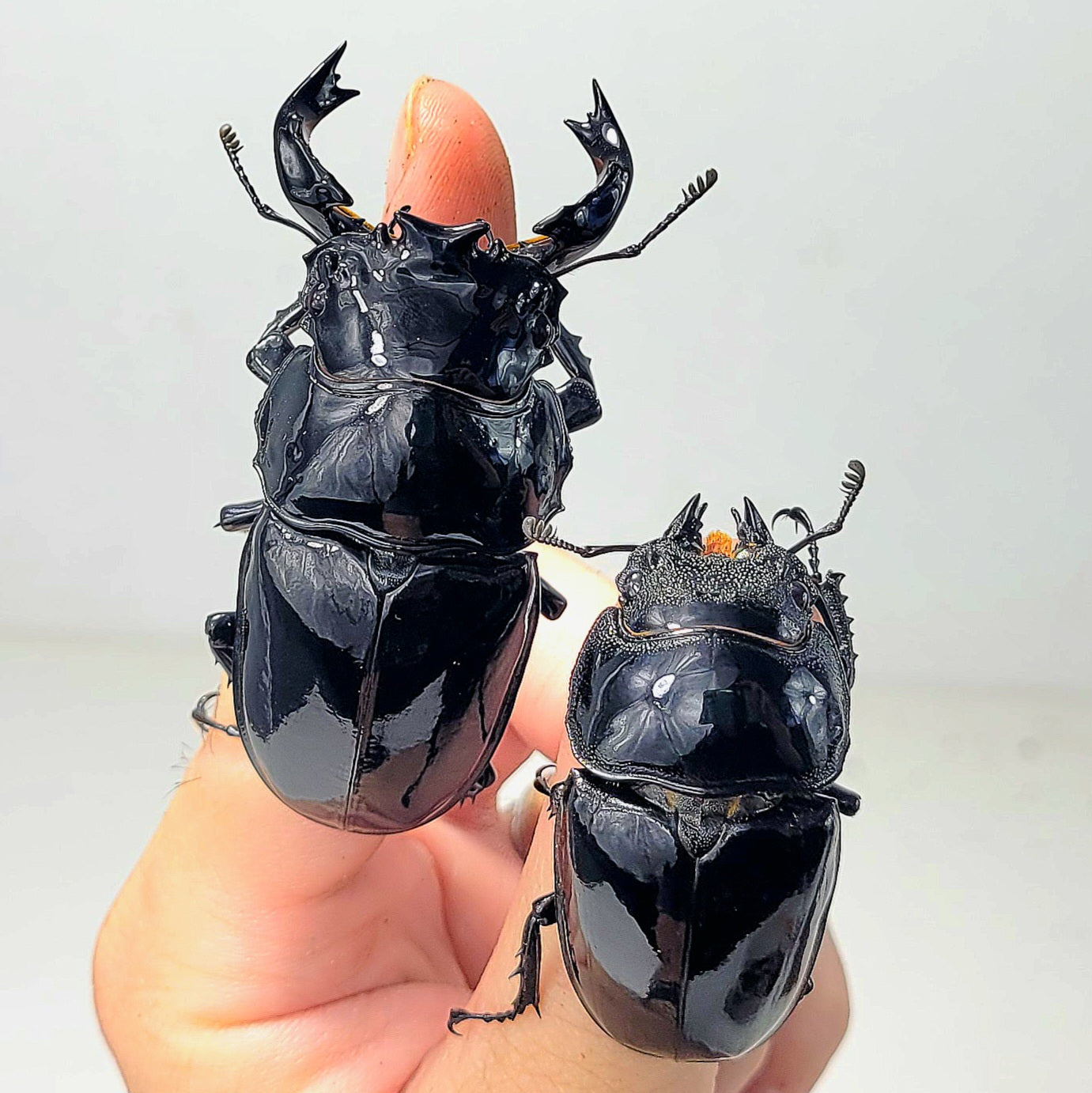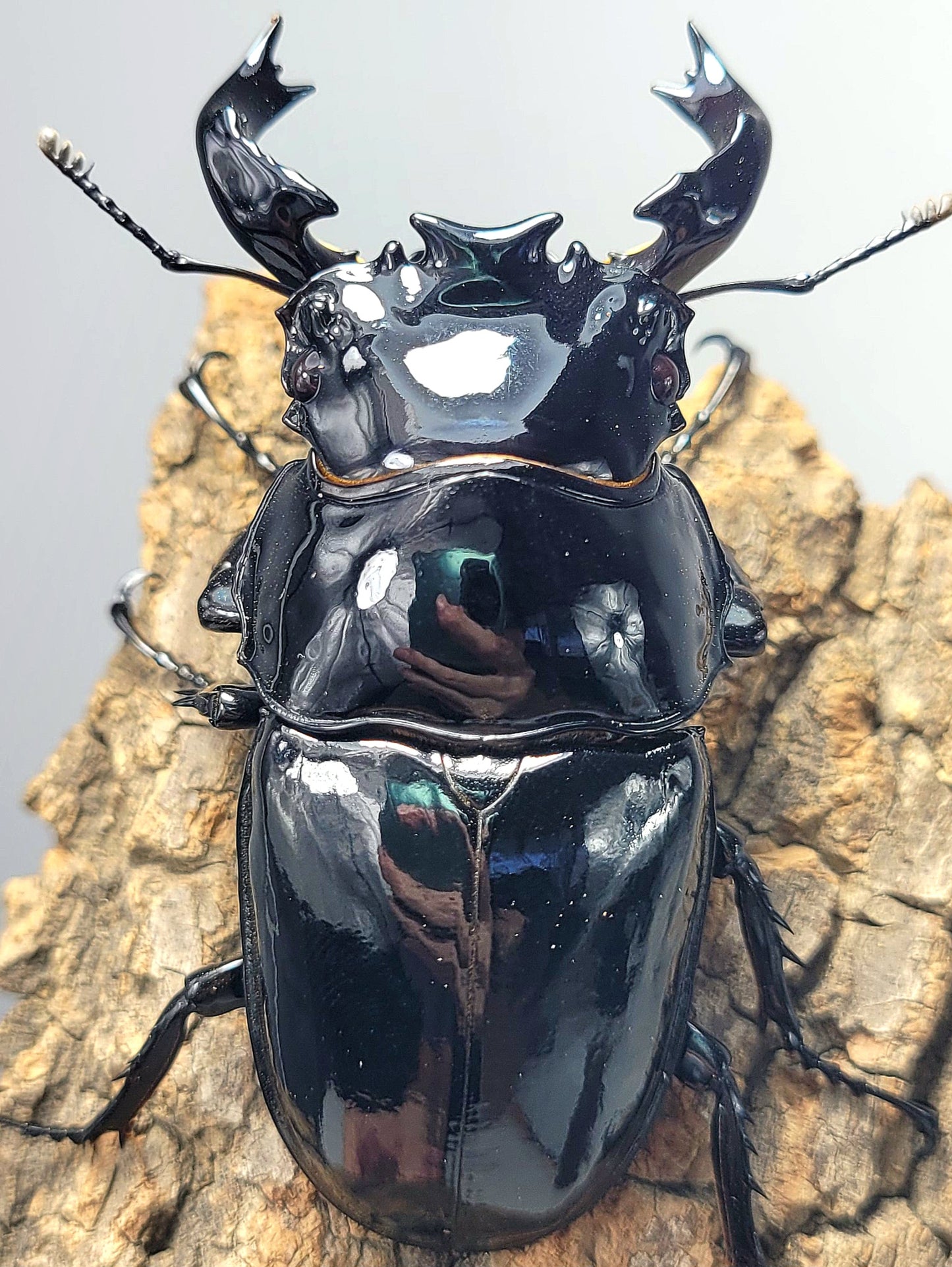James' Beetle Farm
Tarandus Stag Beetle (Mesotopus tarandus)
Tarandus Stag Beetle (Mesotopus tarandus)
Couldn't load pickup availability
Species Summary:
Adult lifespan: 1-2 year
Pupa period: 1 month.
Larva period: Males: 10-12 months, Females 5-8 months.
Breeding difficulty: 7/10
Species Info:
Mesotopus tarandus is a remarkable species of stag beetle prized for its shiny, jet-black exoskeleton and impressive size. Native to Central Africa, this beetle is a favorite among collectors and insect enthusiasts for its striking appearance and relatively easy care requirements.
The Mesotopus tarandus is distinguished by its glossy, black exoskeleton that gives it a polished, almost metallic appearance. Males of this species can reach lengths of up to 70 millimeters, making them one of the larger members of the Lucanidae family. The males are particularly notable for their large, curved mandibles, which they use in battles with other males over territory and mates. Females are generally smaller and have shorter mandibles but still share the same sleek, black coloration.
Mesotopus tarandus is found in the tropical forests of Central Africa, where it inhabits decaying wood and leaf litter. In the wild, these beetles are often associated with turkey tail mushrooms (Trametes versicolor), which grow on decaying logs. The presence of these mushrooms provides a suitable environment for laying eggs. Females prefer to lay their eggs in logs where turkey tail mushrooms are growing, as the mycelium within the wood creates an ideal substrate for the larvae.
The beetles are primarily nocturnal and are most active at night, when they emerge to feed and engage in mating activities. Males are known for their aggressive behavior
when defending territory, often using their mandibles to fend off rivals.
In the wild, this stag beetle feeds on tree sap and decaying fruit. In captivity, they can be
provided with beetle jelly, which is specifically formulated to meet their nutritional needs. Soft fruits like bananas, apples, and mangoes are also suitable additions to their diet. Maintaining a consistent diet is essential for the health and longevity of these beetles.
Breeding Mesotopus tarandus in captivity requires replicating their natural environment as closely as possible. Females will only lay eggs in a substrate known as turkey tail kinishi, which is a specialized medium infused with turkey tail mushroom mycelium. This substrate mimics the decaying wood with mushroom growth that they naturally use in the wild. The larvae must also be raised in turkey tail kinishi to ensure they receive the necessary nutrients for proper development.
The larvae undergo several molts before pupating and eventually emerging as
adults. The entire life cycle can take several months, and maintaining the appropriate
temperature, humidity, and substrate conditions is crucial for successful breeding.
The adult Mesotopus tarandus typically has a lifespan of several years. In captivity, it is important to maintain a warm, humid environment with a substrate of turkey tail kinishi for the larvae.Regular misting and proper ventilation help to maintain the necessary humidity levels and prevent mold growth.
These beetles are generally calm but should be handled with care, especially the males, whose large mandibles can deliver a strong pinch. Gentle handling is recommended to avoid stress or injury to both the beetle and the handler. Their glossy appearance and impressive size make them a captivating species to observe.
Mesotopus tarandus is a stunning and relatively large species from Central Africa. With its sleek, glossy black appearance and specialized breeding requirements, including the use of turkey tail kinishi, it is a rewarding species for beetle enthusiasts. Providing
the right environment and diet will help these beetles thrive in captivity, offering a unique
opportunity to observe their natural behaviors and life cycle.
Share




































